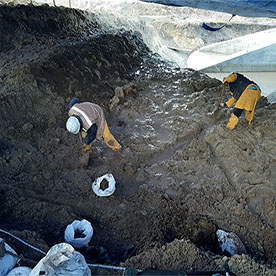PROPUESTA METODOLÓGICA DE EXCAVACIÓN PALEONTOLÓGICA PARA VERTEBRADOS CONTINENTALES EN ÁREAS ACOTADAS CON ALTA HUMEDAD
DOI:
https://doi.org/10.5710/PEAPA.26.03.2023.445Palabras clave:
Paleontología, Metodología de excavación, Rescate paleontológico, Fósiles de vertebrados, Extracción de vertebrados fósilesResumen
El presente artículo tiene como objetivo dar a conocer un caso de estudio donde se aplicaron metodologías para la excavación de restos de vertebrados fósiles en áreas acotadas, en el marco del proceso de monitoreo ambiental en Chile. Este caso resulta de particular interés debido a que se realizó bajo condiciones de alta humedad, durante un periodo de aproximadamente un mes en el que se procesaron ocho toneladas de sedimento. La metodología aplicada consistió en la excavación manual de niveles fosilíferos a través de desmonte lateral de planos horizontales con cuadrículas, desde los niveles superiores hasta la base del estrato portador, con recuperación de fósiles por medio de excavación de planta y bochón seco. Adicionalmente se aplicó la metodología estándar, de acuerdo con el organismo estatal, para la recuperación de microvertebrados mediante lavado y tamizado. Todo el proceso de rescate permitió la extracción de 82 piezas de las cuales el 76% fueron recuperadas in situ, mientras que el 24% fue recuperada por la metodología estándar. En base en lo anterior, se ofrecen recomendaciones para mejorar las propuestas metodológicas para rescate y monitoreo ambiental, ofreciendo una base comparativa para evaluar la efectividad de las técnicas empleadas en futuras labores de rescate.
Referencias
Bisulca, C., Kronthal, L. y Davidson, M. (2009). Consolidation of fragile fossil bone from Ukhaa Tolgod, Mongolia (Late Cretaceous) with conservare OH100. Journal of the American Institute for Conservation,48:1, 37-50.
Brown, M. y Holliday, C. (2021). Non-traditional applications of fire in fossil preparation. Palaeontologia Electronica, 24(2): a22.
Cerda, I., Pereyra, M., Garrone, M., Ponce, D., Navarro, T., González, R., Militello, M., Luna, C., y Jannello J. (2020). A basic guide for sampling and preparation of extant and fossil bones for histological studies. Publicación Electrónica de la Asociación Paleontológica Argentina 20 (1): 15–28. http://dx.doi.org/10.5710/PEAPA.07.04.2020.314
Chechi, F. (2020). Algunas consideraciones sobre las técnicas de excavación arqueológica en obras de construcción. Práctica Arqueología (2): 1-13 (2019) ISSN: 2618-2874
Davidson, A. (2003). Preparation of a fossil dinosaur. Objects Specialty Group Postprints, Volume Ten, 2003 Pages: 49-61. Compilers: Virginia Greene, David Harvey, and Patricia Griffin. The American Institute for Conservation of Historic & Artistic Works, 1156 15th
Street NW, Suite 320, Washington, DC 20005. (202) 452-9545
Davidson, A. (2009). A mini-seminar on adhesives for fossil preparation. In: Methods In Fossil Preparation: Proceedings of the First Annual Fossil Preparation and Collections Symposium, pp 111- 122. Brown, M.A., Kane, J.F., and Parker, W.G. Eds.
Faegri, K. y Iversen, J. (1989). Textbook of pollen analysis. John Wiley & Sons Ld., Londres.
Brooks, S., Langdon, P. y Heiri, O. (2007). The Identification and Use of Palaearctic Chironomidae Larvae in Palaeoecology. QRA Technical Guide No. 10. Quaternary Research Association, London.
Fouquet, N., Mourgues, A., Oyanadel-Urbina, P.A. Chávez Hoffmeister, M. (2018). Consultoría: ¿Herramienta de financiamiento para la investigación paleontológica? I Congreso Chileno de Paleontología, Punta Arenas-Torres del Paine, Chile.
Frew, C. (2014). Coring Methods. In Cook, S., Clarke, L. y Nield, J. (eds) Geomorphological Techniques (Online Edition). British Society for Geomorphology, London.
Gallardo, F. y Cornejo, L. (1986). El diseño de la prospección arqueológica: un caso de estudio. Revista Chungara, N°16-17, 409-420.
Green, O. (2021). A manual of practical laboratory and field techniques in paleobilogy. Springer-Science, Business Medina, B.V.
Isasi, M. y Brissón, F. (2018). Técnicas paleontológicas. Ciencia Hoy, Asociación Civil, Ciencia Hoy.
Jiménez, F., Martin de Jesús, S. (1992). Sobre las técnicas de excavación paleontológica y sus variantes. Paleontología y sociedad, Sociedad Española de Paleontología y Departamento de estratigrafía y paleontología. Universidad de Granada. pp.113-119.
Melendi, D., Scafati, L., Volkheimer, W. y Chavez, R. (2009). Técnicas extractivas y preparativas en paleontología. Aspectos ambientales y de seguridad laboral. Revista del Museo Argentino de Ciencias Naturales, n.s.11(1).
Maltese, A. (2009). Difficult excavation and preparation of a large Daspletosaurus specimen. In: Methods in Fossil Preparation: Proceedings of the First Annual Fossil Preparation and Collections Symposium, pp 63-68. Brown, M, Kane, J y Parker, W. Eds.
Martel-Cea, A., Astorga, G., Hérnandez, M., Caputo, L., Abarzúa, A. (2021). Modern Chironomids (Diptera: Chironomidae) and the environmental variables that influence their dristribution in the Araucanian lakes, south-central Chile. Hidrobilogia. https://doi.org/10.1007/s10750-021-04575-0
Morín de Pablos, J., Malalana, A., Sánchez, I. (2014). Metodología arqueológica: Prospección, excavación, investigación, difusión y divulgación. en “Los paisajes culturales del Valle de Cigüela”. Ed. científico: Jorge Morín de Pablos. Auditores de Energía y Medio Ambiente S.A. Madrid.
LEY 17.288 (2019). De Monumentos Nacionales y Normas Relacionadas. 7° Edición. Consejo de Monumentos Nacionales.
Otero A., Pérez Moreno A., Falkingham, P., Cassini, G., Ruella, A., Militello, M. y Toledo N. (2020). Three-dimensional image surface acquisition in vertebrate paleontology: a review of principal techniques. Publicación Electrónica de la Asociación Paleontológica Argentina 20 (1): 1–14. http://dx.doi.org/10.5710/PEAPA.04.04.2020.310
Peterson, R., D´Andrea, N., Heckert A. (1999). The rondan jacket support clamp and jacket transport sled. New Mexico´s fossil record 2. Lucas S. ed. New Mexico Museum of Natural History and Science Bulletin No. 16.
Palacios, E. (2020). Guía de procedimientos arqueológicos. Consejo de Monumentos Nacionales, Ministerio de la Artes, Cultura y Patrimonio, Gobierno de Chile. 1a Edición.
Resolución Exenta N°650 (2022). Actualización de antecedentes profesionales para la obtención de permisos de intervención paleontológica y realización de trabajos en paleontología aplicada en materias de competencia del consejo de monumentos nacionales.
Reuil S., Muzzopappa, P. (2019). 3D Cast from natural molds: A case study in fossil frogs. Publicación Electrónica de la Asociación Paleontológica Argentina 19 (1): 1-6. http://dx.doi.org/10.5710/PEAPA.14.04.2019.280
Rincón, I., Gutstein, C. (2016). Guía de informes paleontológicos. Consejo de Monumentos Nacionales. Chile.
Russell, R. y Strilisky, B. (2016). Keep it together: An evaluation of the tensile strengths of three select adhesives used in fossil preparation. Collection Forum. 30 (1): 85-95. Society for the Preservation of Natural History Colletions.
SEA. (2012). Guía de Evaluación de impacto ambiental Monumentos Nacionales pertenecientes al patrimonio cultural en el SEIA. Editor: Servicio de Evaluación Ambiental. Diseño y Diagramación: Nicole Michel Aravena. ISBN: 978-956-9076-13-8.
Shávelzon, D. (2015). Manual de arqueología urbana: Técnicas para excavar Buenos Aires. Centro de Arqueología Urbana, Instituto de Arte Americano “M. J. Buschiazzo”, Facultad de Arquitectura, Diseño y Urbanismo, Universidad de Buenos Aires.
Whitlock, C. y Larsen, C. (2001). Charcoal as a proxy fire. In Smol, J., Birks H. y Last W. (eds) Tracking Environmental Change Using Lake Sediments: Terrestrial, Algal, and Siliceous Indicators. vol 3. Kluwer Academic Publishers, Dordrecht, The Netherlands, 75-97
Wright, H., Mann D. y Glaser, P. (1984). Piston corers for peat and lake sediments. Ecology 65:657–659.
Wylie, C. (2009). Preparation in action: paleontological skill and the role of the fossil preparator. In: Methods In Fossil Preparation: Proceedings of the First Annual Fossil Preparation and Collections Symposium, pp 3-12. Brown, M.A., Kane, J.F., and Parker, W.G. Eds.

Archivos adicionales
Publicado
Número
Sección
Licencia
Derechos de autor 2023 Jorge Campos-Medina, Martín Chávez-Hoffmeister, Pablo Oyanadel-Urbina, Jorge Bolomey-Badilla, Estefania Fernandez, Esteban Rodríguez, Carolina Sandoval, Matias González, Liz Vilches, Tomas Soto, Javiera Bravo

Esta obra está bajo una licencia internacional Creative Commons Atribución-SinDerivadas 4.0.

Los/las autores/as conservan los derechos de autor/a y garantizan a la revista el derecho de ser la primera publicación del trabajo licenciado bajo una licencia CC Attribution-NonCommercial 4.0 que permite a otros/as compartir el trabajo con el reconocimiento de la autoría y de la publicación inicial en esta revista.














